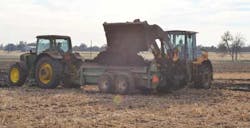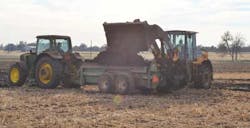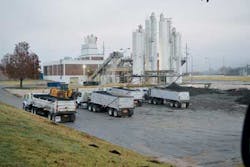BY PATRICK CORBETT
As municipal budgets continue to tighten, cities across the United States are seeking cost-effective ways to best manage their infrastructure and identify savings. With this in mind, more cities are looking to expand from a traditional treatmentand-disposal approach to one that centers on resource recovery and fnding value in waste.
Oklahoma City has experienced signifcant success with its 18,000-acre permitted cropland biosolids reuse program. Developed and implemented by Veolia Water North America as part of a 25-year public-private partnership with the city, the program has reduced sludge disposal costs and provides local farmers with a soil amendment at zero cost to the landowner. The program currently produces a combined total of 25,000 dry tons of Class B biosolids per year.
BACKGROUND
Before the partnership, Oklahoma City had already experimented with several biosolids land application methods. The goal was to fnd a sustainable way to reuse biosolids generated by its wastewater facilities. Its frst experiments were in liquid land application, but the city found that hauling the heavy, wet biosolids was expensive and unsustainable.
In 1988, Oklahoma City and Veolia Water determined that belt press technology could be integrated into the facilities to remove liquid from the biosolid stream. This process accelerated the program. By taking dewatered solids to the feld instead of liquid sludge, the city found that its hauling costs were reduced. This made the process more effcient and fnancially sustainable.
HOW IT WORKS
All four of the city's wastewater facilities participate in the biosolids reuse program, and up to 100,000 wet tons of biosolids are treated and processed each year. Veolia Water monitors and treats the waste stream at each facility, minimizing contaminants that would make the biosolids unft for use in the land application program.
"Our product goes through testing to ensure that contaminants don't come in at levels that are above regulatory levels," said Wade Braxton, Veolia Water biosolids supervisor. "Because we monitor the waste stream from the start, we are able to treat the biosolids in a manner that minimizes contaminants in order to produce Class B quality sludge for the program."
As Class B biosolids, the product can only be applied to land designated for non-human consumption crops.
Belt presses remove water from the treated biosolids, making it lighter and easier to transport. Currently, three of Oklahoma City's wastewater treatment facilities — Deer Creek, South Canadian and North Canadian — use a belt press. The other facility, Chisholm Creek, transports liquid waste to Deer Creek to be belt-pressed.
Lime is added to the biosolids to stabilize the mixture by increasing the pH above 12. The lime destroys any remaining pathogens, making the biosolids safe for land application. Additionally, the lime serves as a benefcial soil amendment.
While the city continuously produces biosolids, weather and the needs of farmers vary. The treated biosolids are transported to the North Canadian facility for storage until needed, since it is located in a more rural area. Approximately 30 loads of biosolids are picked up from the facilities each day.
Once at the North Canadian facility, the biosolids are placed into a stacking pad — a one-acre, concrete-lined depression with a sloped bottom ranging from 12' to 14' deep. The sloped bottom allows for water drainage. The biosolids are staged there until loaded for land application.
When needed, multiple 20-yard trucks haul the biosolids to designated farmland where it is applied to specifed areas marked with fags to protect adjacent property, streams and roadways. Tractors pulling spreaders flled with biosolids apply the product. Another tractor follows with a tiller to mix the biosolids with the dirt. An odor neutralizer is applied to the land as a fnal step if necessary.
"With today's cost of fuel, providing free soil amendment and tilling services to farmers adds up. Fields that don't get the biosolids land application look barren compared to those that do," said Braxton.
RETURN ON INVESTMENT
To make this program work, the city needed to invest in belt presses and dedicate employees to ensure that the program operated at a steady pace; Veolia Water provided the trucks and tractors.
The investment has paid off. The city's biosolids solution is fnancially sustainable and effcient. It also benefts the local agricultural community and reduces costs that were previously incurred with biosolids disposal.
"Instead of sending this material to landfll or incineration, we can input a minimal amount of fuel, manpower and energy and get a wonderful product that helps farmers and saves the city money. It's really been successful," said Braxton.
GETTING A PROGRAM STARTED
Not all states allow the application of treated biosolids to farmland.
"To start a similar program, cities should frst check state and local regulations to determine if this type of program is even an option," said Braxton. "Second, talk to local farmers about the benefts of this program — free soils amendment and free tilling — and determine if they have any interest in taking part. Once you have customers, you can get the program moving."
The program in Oklahoma City has been in operation for more than 20 years and has won several awards, including the EPA Regional Administrators Environmental Excellence Award for "Operating Facilities Benefcially Using Sewage Sludge."
WATER PARTNERSHIP
Oklahoma City partnered with Veolia Water in 1988. The partnership began with the management of the city's 80 mgd tertiary activated sludge wastewater treatment plant, and later expanded to include the management of a 10 mgd tertiary activated sludge plant, 15 mgd activated sludge plant and 75 mgd Witcher Pump Station. Additionally, in 1991, Veolia Water started managing a 6 mgd sequencing batch reactor plant for the city. In total, the facilities can process a combined 106 million gallons of residential and commercial wastewater each day.
About the Author: Patrick Corbett is Veolia Water's project manager for Oklahoma City wastewater treatment facilities. He has held this position since 2011. Corbett can be reached at [email protected].
http://www.waterworld.com/index/current-issue.html">More WaterWorld Current Issue Articles http://www.waterworld.com/index/Past_Issues.html">More WaterWorld Archives Issue Articles





